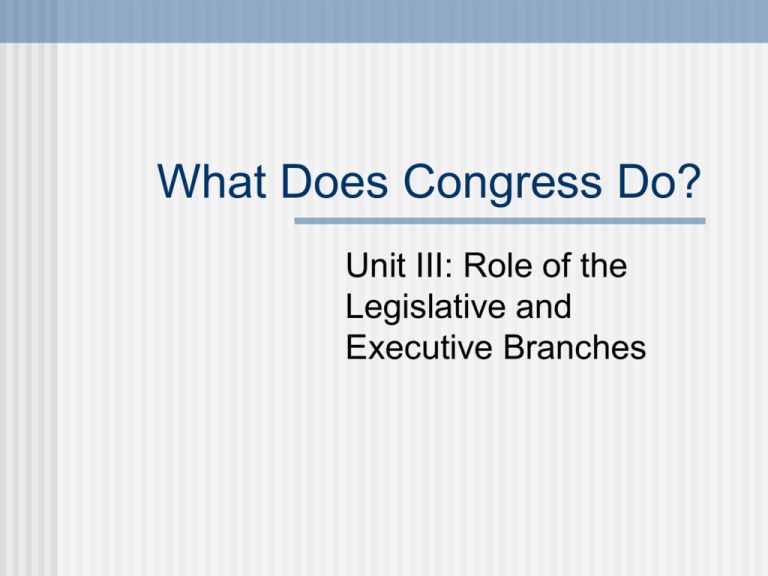What Does Congress Do?
advertisement

What Does Congress Do? Unit III: Role of the Legislative and Executive Branches What does Bi-Cameral mean? There are two houses that make up the legislature. House of Representatives Senate This can be traced all the way back to the British Parliament in the 1300’s. House of Representatives 435 total members Based on population in each state Each state has a minimum of ONE representative. California has the most representatives with 53, North Dakota has 1. Each term(length served in office) lasts for 2 years. How many representatives does Minnesota have? Who is your representative? Minnesota has 8 representatives!! Depending on where you live, you may not all have the same representative. The majority of you are represented by Betty McCollum. Representative Betty McCollum Will Minnesota Always Have 8 Representatives? Not necessarily-there will always be 435 members of the House. Reapportion (redistribute the seats after the census) States can gain or lose representatives based on population. Each state is guaranteed 1. In 2010, MN almost lost a representative due to lack of response in returning the census. Formal Qualifications for the House of Representatives 1. Must be at least 25 years of age 2. Must be a citizen of the U.S. for at least 7 years 3. Must live in the state from which he or she is elected. Senate 100 members 2 senators from each state, regardless of population Each term lasts for 6 years and terms are staggered so only 1/3 of the senate is up for re-election at one time How many Senators does Minnesota have? What are the names of your Senators? Minnesota has 2 senators Al Franken Amy Klobachar Formal Qualifications for the Senate Must be at least 30 years of age Must be a citizen of the U.S. for at least 9 years. Must live in the state from which he or she is elected. Personal Backgrounds The average member is a white male in his early 50’s. There are more African American and women in Congress than ever before. When Barack Obama was elected to the Senate, he was only the 5th African American member of the Senate. Senator (and now President) Barack Obama) Personal Backgrounds Nearly all members are married On average they have 2 children 60% are Protestant, 30% are Catholic, 6% are Jewish 1/3 of the House are lawyers, 1/2 of the Senate are lawyers 4 out of 5 members have college degrees Most were born in the state they represent Most members depend on their salary and are not independently wealthy Compensation Representatives are paid $158,000 a year Special tax deduction on homes (one in DC and one in the state represented) Retirement at $150,000 per year Franking Privilege: can mail letters and other materials for free There is no limit as to how much money a representative can make, but there is always fear of voter backlash. Congressional Power Congress only has the powers that were given to it by the Constitution. There are three types of powers: Expressed: directly from the Constitution Implied: powers reasonably deduced Inherent: used to create a national government Specific Powers of Congress Power to Tax Commerce Power Currency Power War Powers Naturalization Postal Power Constitutional Amendments Impeachment: to charge with a crime, not removal from office Executive Powers How Congress Organizes House of Representatives has it’s opening day every other January. The Senate has been organized without interruption since 1789. Presiding officer of the House: Speaker of the House, John Bainer. Presiding officer of the Senate: VP, Joe Bidon. President pro tempore: serves in the VP’s absence, Senator Daniel Inouye (Hawaii) Speaker of the House: John Boehner President of the Senate: Joe Biden President pro tempore of the Senate: Daniel Inouye Committees in Congress Way to divide up the work load in the House and Senate. This is where bills are presented and researched. Standing Committee: some committees are permanent, the House has 19 and the Senate has 17. Committees include: Agriculture, Education, Budget, Homeland Security, Veterans Affairs, Ways and Means, etc…. How a Bill becomes a Law Bill: a proposed law presented to the House or Senate for consideration. Step 1: It is introduced Step 2: Referred to a standing committee for research, hearings, etc. Step 3: Bill is debated on the floor and then passed or defeated. If passed, it goes on to the other “house” of Congress. How a Bill becomes a Law Step 4: Conference Committee resolves the differences between the House and Senate versions of the bill. Step 5: House and Senate vote on the bill, approved bill is sent to the president. Step 6: President vetoes or signs the bill. If vetoed, the bill goes back to Congress.








